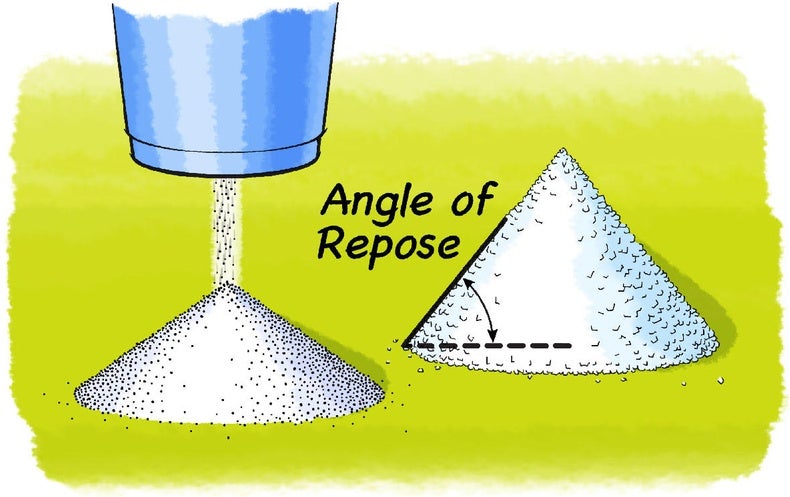Angle of Repose Experiment
Using particulate collection on small marbles the measured angles of repose compare well to experimental data and theoretical predictions. The rougher the base was the higher was the angle of repose.

Angle Of Repose Experiments With Snow Role Of Grain Shape And Cohesion Journal Of Glaciology Cambridge Core
The critical angle of repose ac is defined as the angle through which a mass of granular material can be rotated before it fails by avalanching and the angle of rest aR is defined as the inclination of the slope after avalanching has ceased.
. Abstract Snow appears as a granular material in most engineering applications. The present work calibrates the Student Nanoexperiments for Outreach and Observational Planetary Inquiry SNOOPY Angle of Repose experiment. Angle of repose as a function of rolling friction coefficient between particle and wall with μspp 04 and different μrpp.
Angle of repose experiment with books it shows how friction is directly proportional to normal. The role of shape was examined by investigating diverse snow types with discernable shape and spherical ice beads. The angle of repose is a classical measure for the investigation of granular materials Al-Hashemi and Al-Amoudi 2018.
UW-Madison GEOSCI 106 Fall 2019 Final ProjectRobert LegatzkeSebastian RealWill Hope. For future Mars Lander missions it is crucial to gain information about the ideal angle. B the mode of failure of the conical pile of.
Additional information is contained in the original extended abstract. We examined the role of grain shape and cohesion in angle of repose experiments which are a common means for the characterization of granular materials. Introduction The angle of repose is a classical measure for the investigation of granular materials Al-Hashemi and Al-Amoudi 2018.
The thermal deformation problem is quite serious for the workbench of the environmental dry hobbing machine due to the thermal accumulation of hot chips. Sliding friction governs the translational motion of particles. In this paper we present an experimental setup and measurements for the angle of repose of snow for seven different snow samples over a large range of temperatures.
Solid lines are calculated results by Eq. They were used to examine granular snow dynamics on the grain-scale with focus on the role of grain shape and cohesion. And line 1 μrpp 005 mm.
The angle of repose was observed by sieving snow onto a round freestanding base until a stationary heap was formed. The experiments highlight the relevance of these parameters in granular snow mechanics and can be used for model calibration. From the laboratory experiments the following conclusions can be made.
Additionally experiments were conducted with industrial mono-sized glass beads GB as a cohesionless reference. A better understanding of the quantity and optimization of the chip repose angle is quite necessary to reduce the workbench thermal deformation. Hence this paper focuses on the chip repose.
Angle of repose experiments In our study we focus on the influence of particle shape and cohesion on the angle of repose by comparing the angles of dif-ferent snow types at various temperatures under identical experi-mental conditions. Two angles of repose are measured by this method. Angle of repose experiments were performed with different snow types at temperatures between -2 and -40C.
And line 2 μrpp 01 mm. The results show that the angle of repose is dependent on the fall. The angle of repose is a measure reflecting the internal friction and cohesion properties of a granular material.
As a characteristic of a granular material it depends on particle and material properties such as size distribution and shapes of the granules inter-particle friction surface roughness and cohesion. Markers are simulation results. A the angle of repose of the granular systems was influenced by the degree of roughness of the base on which the grains came to rest.
Adding sand onto the top of a pile demonstrates how the slope angle angle of repose is readjusted to remain about 35 degrees. Experimental Study of the Angle of Repose of Surrogate Martian Dust Accumulation of wind-blown dust particles on solar cells and instruments will be a great challenge in the exploration of Mars significantly reducing their lifetime durability and power output.

Practical Determination Of Angle Of Repose Carre S Index Hausner Ratio Of Given Powder

Slippery Slopes And The Angle Of Repose Scientific American
Schematic Representation Of The Experimental Setup For The Angle Of Download Scientific Diagram

Angle Of Repose How To Perform In Laboratory Detail Calculation Importance Of Flow Property Youtube
No comments for "Angle of Repose Experiment"
Post a Comment